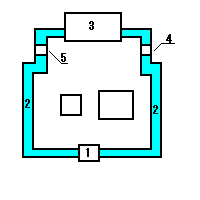| No. |
Picture | Name | Description |
|---|
| 1 |
 | Chumon | Central Gate:
National treasure
The structure might have been not only an entrance gate, but a hall for ceremonial events. At the both sides of the gate,
tall statues called
Kongoh-Rikishi are standing. (see next page)
The gate and Kongoh-Rikishi were, upon various documents, erected by 711 at the latest. |
| 2 |
 | Kairoh | Cloister-Gallery or Corridor:
National treasure
The Cloister-Gallery surrounds the Main Hall and the Pagoda, having lattice windows. The convexed
swollen columns are so-called entasis which is featured in ancient Greek architectures. |
| 3 |
 | Daikohdoh | Great Lecture Hall: National
treasure
Originally, this hall was erected for monks to study Buddhism. In 925 it was struck by lightning and burnt down.
In 990 the current hall was re-erected, enshrining Yakushi (Healing) triad. |
| 4 |
 | Shohroh | Bell house: National treasure
The Bell house was also burnt down by the fire of the Great Lecture Hall in 925. It was re-erected at the same time of
re-erection of the Lecture Hall. The bell itself was made of bronze and flawless at the fire. Today, we can hear the sound
of the bell cast at the time of foundation of the Main Hall. |
| 5 |
 | Kyohzoh | Sutra Repository:
National treasure
Originally, this structure was built as a facility to store sutras, scriptual narratives in Buddhism.
Currently, it houses a seated image of Kanroku Sohjoh ,
the scholarly monk from ancient Korean kingdom of Paekche, who was the first to convey the disciplines of astronomy and
geography to Japan. |








